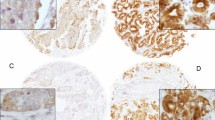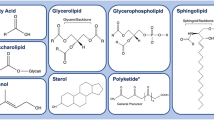Abstract
Breast cancer is the most common cancer in women worldwide. Aberrant lipid metabolism is an established hallmark of cancer cells. The recently isolated lysophosphatidylcholine acyltransferase 1 (LPCAT1), the most important enzyme in membrane biogenesis, has been currently implicated in cancer development and progression. The published literature lacks comprehensive reports on LPCAT1 expression in breast cancer and its impact on patients’ outcome. We evaluated the immunohistochemical expression of LPCAT1 in 80 primary breast carcinomas, 24 metastatic lymph nodes, and 30 non-neoplastic breast tissue specimens and statistically analyzed the association between LPCAT1 expression and clinicopathological variables and patients’ outcome. LPCAT1 protein was significantly upregulated in primary breast carcinoma and showed a significant ascending pattern being the lowest in normal breast tissues, relatively increased in fibrocystic disease, and the highest in primary carcinoma. LPCAT1 expression was significantly higher at tumor’s advancing edge and correlated positively with tumor’s grade and TNM stage. Compared to primary tumor, LPCAT1 expression was significantly lower in ductal carcinoma in situ and significantly higher in metastatic lymph nodes. LPCAT1 overexpression was significantly associated with increased proliferative activity, negative estrogen receptor (ER) and progesterone receptor (PR) status, positive human epidermal growth factor receptor 2 (HER2) status, as well as triple-negative and HER2 disease molecular subtypes. Multivariate analysis showed that advanced stage, high grade, and LPCAT1 overexpression were independent predictors of early tumor recurrence. We conclude that LPCAT1 is implicated in breast cancer pathogenesis, evolution, and progression and appears to play a potentially crucial role as a determinant of local invasiveness and metastasis. LPCAT1 is an independent predictor of early tumor recurrence of breast carcinoma and represents a novel prognostic biomarker that reflects underlying biological alterations and thus constitutes a potentially promising target for new therapeutic strategies.



Similar content being viewed by others
References
Jemal A, Bray F, Center MM, Ferlay J, Ward E, Forman D. Global cancer statistics. CA Cancer J Clin. 2011;61(2):69–90. doi:10.3322/caac.20107.
Hirko KA, Soliman AS, Ahmed Hablas, et al. (2013) Trends in breast cancer incidence rates by age and stage at diagnosis in Gharbiah, Egypt, over 10 years (1999–2008). Journal of Cancer Epidemiology, vol. 2013, Article ID 916394, 7 pages. doi:10.1155/2013/916394
Madu CO, Lu Y. Novel diagnostic biomarkers for prostate cancer. J Cancer. 2010;1:150–77. doi:10.7150/jca.1.150.
Mansilla F, da Costa KA, Wang S, Kruhøffer M, Lewin TM, Orntoft TF, et al. Lysophosphatidylcholine acyltransferase 1 (LPCAT1) overexpression in human colorectal cancer. J Mol Med (Berl). 2009;87(1):85–97. doi:10.1007/s00109-008-0409-0.
Bridges JP, Ikegami M, Brilli LL, Chen X, Mason RJ, Shannon JM. LPCAT1 regulates surfactant phospholipid synthesis and is required for transitioning to air breathing in mice. J Clin Invest. 2010;120(5):1736–48. doi:10.1172/JCI38061.
Ekroos K, Ejsing CS, Bahr U, Karas M, Simons K, et al. Charting molecular composition of phosphatidylcholines by fatty acid scanning and ion trap MS3 fragmentation. J Lipid Res. 2003;44:2181–92. doi:10.1194/jlr. D300020-JLR200.
Soupene E, Kuypers FA. Phosphatidylcholine formation by LPCAT1 is regulated by Ca(2+) and the redox status of the cell. BMC Biochem. 2012;7(13):8. doi:10.1186/1471-2091-13-8.
Yamazaki T1, Wakabayashi M, Ikeda E, Tanaka S, Sakamoto T, Mitsumoto A, et al. Induction of 1-acylglycerophosphocholine acyltransferase genes by fibrates in the liver of rats. Biol Pharm Bull. 2012;35(9):1509–15. doi:10.1248/bpb. b12-00243.
Nakanishi H, Shindou H, Hishikawa D, Harayama T, Ogasawara R, Suwabe A, Taguchi R, Shimizu T (2006) Cloning and characterization of mouse lung-type acylCoA:lysophosphatidylcholine acyltransferase 1(LPCAT1). Expression in alveolar type II cells and possible involvement in surfactant production. J Biol Chem. 21;281(29):20140-20147. doi:10.1074/jbc.M600225200.
Lands WE (2000) Stories about acyl chains. Biochim Biophys Acta. 3;1483(1):1-14. DOI: 10.1016/S1388-1981(99)00177-8.
Soupene E, Fyrst H, Kuypers FA (2008) Mammalian acyl-CoA:lysophosphatidylcholine acyltransferase enzymes. Proc Natl Acad Sci U S A. 8;105(1):88-93. doi: 10.1073/pnas.0709737104.
Chen X, Hyatt B, Mucenski M, Mason R, Shannon J. Identification and characterization of a lysophosphatidylcholine acyltransferase in alveolar type II cells. Proc Natl Acad Sci U S A. 2006;103:11724–9. doi:10.1073/pnas.0604946103.
Agarwal AK, Sukumaran S, Bartz R, Barnes RI, Garg A. Functional characterization of human 1-acylglycerol-3-phosphate-O acyltransferase isoform 9: cloning, tissue distribution, gene structure, and enzymatic activity. J Endocrinol. 2007;193(3):445–57. doi:10.1677/JOE-07-0027.
Harayama T, Shindou H, Shimizu T. Biosynthesis of phosphatidylcholine by human lysophosphatidylcholine acyltransferase 1. J Lipid Res. 2009;50(9):1824–31. doi:10.1194/jlr. M800500-JLR200.
Zhou X, Lawrence TJ, He Z, Pound CR, Mao J, Bigler SA. The expression level of lysophosphatidylcholine acyltransferase 1 (LPCAT1) correlates to the progression of prostate cancer. Exp Mol Pathol. 2012;92(1):105–10. doi:10.1016/j.yexmp.2011.11.001.
Kikuchi H, Uehara T, Setoguchi T, Yamamoto M, Ohta M, Kamiya K, et al. 2012 Overexpression of LPCAT1 and concomitant lipid alterations in gastric cancer. Cancer Research 72(8) .doi: 10.1158/1538-7445.AM2012-3022.
Lakhani SR, Ellis IO, Schnitt SJ, Tan PH, van de Vijver, M.J, eds. (2012) WHO classification of tumours of the breast, IARC Press, Lyon, France, Volume 4, 4th ed.
Elston CW, Ellis IO. Pathological prognostic factors in breast cancer. I. the value of histological grade in breast cancer: experience from a large study with long-term follow-up. Histopathology. 1991;19(5):403–10. doi:10.1111/j.1365-2559.1991.tb00229.
Edge SB, Byrd DR, Compton CC, Fritz AG, Greene FL, Trotti A, eds. (2010) AJCC cancer staging manual. Springer, New York, 7th ed.
Hammond MEH, Hayes DF, Dowsett M, Allred DC, Hagerty KL, Badve S, et al. American Society of Clinical Oncology/College of American Pathologists guideline recommendations for immunohistochemical testing of estrogen and progesterone receptors in breast cancer. J Clin Oncol. 2010;28:2784–95.
Wolff AC, Hammond MEH, Schwartz JN, Hagerty KL, Allred DC, Cote RJ, et al. American Society of Clinical Oncology/College of American Pathologists guideline recommendations for human epidermal growth factor receptor 2 testing in breast cancer. J Clin Oncol. 2007;25:118–45. doi:10.1200/JCO.2006.09.2775.
Fisher B, Brown AM, Dimitrov NV, et al. Two months of doxorubicin-cyclophosphamide with and without interval reinduction therapy compared with 6 months of cyclophosphamide, methotrexate, and fluorouracil in positive-node breast cancer patients with tamoxifen-nonresponsive tumors: results from the National Surgical Adjuvant Breast and Bowel Project B-15. J Clin Oncol. 1990;8(9):1483–96.
Mansour EG, Gray R, Shatila AH, et al. Survival advantage of adjuvant chemotherapy in high risk node-negative breast cancer: ten year analysis—an intergroup study. J Clin Oncol. 1998;16:3486–92.
Altman DG, McShane LM, Sauerbrei W, Taube SE. Reporting Recommendations for Tumor Marker Prognostic Studies (REMARK): explanation and elaboration. PLoS Med. 2012;9(5):e1001216. doi:10.1371/journal.pmed.1001216.
Dowsett M, Nielsen TO, A’Hern R, Bartlett J, Coombes RC, Cuzick J, et al. Assessment of Ki67 in breast cancer: recommendations from the International Ki67 in Breast Cancer Working Group. J Natl Cancer Inst. 2011;103:1656–64. doi:10.1093/jnci/djr393.
Nishimura R, Osako T, Okumura Y, Hayashi M, Toyozumi Y, et al. Ki-67 as a prognostic marker according to breast cancer subtype and a predictor of recurrence time in primary breast cancer. Exp Ther Med. 2010;1:747–54. doi:10.3892/etm.2010.133.
Ide Y, Waki M, Hayasaka T, Nishio T, Morita Y, et al. Human breast cancer tissues contain abundant phosphatidylcholine (36:1) with high stearoyl-CoA desaturase-1 expression. PLoS ONE. 2013;8(4):e61204. doi:10.1371/journal.pone.0061204.
Ferlay J, Soerjomataram I, Ervik M, Dikshit R, Eser S, Mathers C, et al. Cancer incidence and mortality worldwide. Lyon: IARC Press; 2013.
Menendez JA, Lupu R. Fatty acid synthase and the lipogenic phenotype in cancer pathogenesis. Nat Rev Cancer. 2007;7:763–77. doi:10.1038/nrc2222.
Ridgway ND. The role of phosphatidylcholine and choline metabolites to cell proliferation and survival. Crit Rev Biochem Molec. 2013;48(1):20–38. doi:10.3109/10409238.2012.735643.
Podo F, Saradanelli F, Iorio E, Canese R, Carpinelli G, et al. Abnormal choline phospholipid metabolism in breast and ovary cancer: molecular bases for noninvasive imaging approaches. Curr Med Imag Rev. 2007;3:123–37. doi:10.2174/157340507780619160.
Bougnoux P, Chajes V, Lanson M, Hacene K, Body G, et al. Prognostic significance of tumor phosphatidylcholine stearic acid level in breast carcinoma. Breast Cancer Res Treat. 1992;20:185–94.
Hilvo M, Denkert C, Lehtinen L, Muller B, Brockmoller S, et al. Novel theranostic opportunities offered by characterization of altered membrane lipid metabolism in breast cancer progression. Cancer Res. 2011;71:3236–45. doi:10.1158/0008-5472.CAN-10-3894.
Mauvoisin D, Mounier C. Hormonal and nutritional regulation of SCD1 gene expression. Biochimie. 2011;93:78–86. doi:10.1016/j.biochi.2010.08.001.
Holder AM, Gonzalez-Angulo AM, Chen H, Akcakanat A, Do KA, et al. High stearoyl-CoA desaturase 1 expression is associated with shorter survival in breast cancer patients. Breast Cancer Res Treat. 2013;137:319–27. doi:10.1007/s10549-012-2354-4.
Hishikawa D, Shindou H, Kobayashi S, Nakanishi H, Taguchi R, et al. Discovery of a lysophospholipid acyltransferase family essential for membrane asymmetry and diversity. Proc Natl Acad Sci U S A. 2008;105:2830–5. doi:10.1073/pnas.0712245105.
Ellis B, Kaercher L, Snavely C, Zhao Y (2012) Lipopolysaccharide triggers nuclear import of Lpcat1 to regulate inducible gene expression in lung epithelia. Chunbin ZouWorld J Biol Chem 26; 3(7): 159-166. doi: 10.4331/wjbc.v3.i7.159.
Grupp K, Sanader S, Sirma H, Simon R, et al. High lysophosphatidylcholine acyltransferase 1 expression independently predicts high risk for biochemical recurrence in prostate cancers. Online Molec Oncol. 2013;7(6):1001–11. doi:10.1016/j.molonc.2013.07.009.
Davis ID, Birrell SN, et al. Breast and prostate cancer: more similar than different. Nat Rev Cancer. 2010;10:205–12. doi:10.1038/nrc2795.
Sorlie T, Tibshirani R, Parker J, Hastie T, Marron JS, et al. Repeated observation of breast tumor subtypes in independent gene expression data sets. Proc Natl Acad Sci U S A. 2003;100:8418–23.
Shindou H, Hishikawa D, Harayama T, Yuki K, Shimizu T. Recent progress on acyl CoA: lysophospholipid acyltransferase research. J Lipid Res. 2009;50(Suppl):S46–51. doi:10.1194/jlr. R800035-JLR200.
Zhao Y, Chen YQ, Bonacci TM, Bredt DS, Li S, et al. Identification and characterization of a major liver lysophosphatidylcholine acyltransferase. J Biol Chem. 2008;283:8258–65. doi:10.1074/jbc.M710422200.
Cheng AS, Culhane AC, Chan MW, Venkataramu CR, Ehrich M, et al. Epithelial progeny of estrogen-exposed breast progenitor cells display a cancer-like methylome. Cancer Res. 2008;68:1786–96. doi:10.1158/0008-5472.CAN-07-5547.
Yoon S, Lee MY, Park SW, Moon JS, Koh YK, et al. Up-regulation of acetyl-CoA carboxylase alpha and fatty acid synthase by human epidermal growth factor receptor 2 at the translational level in breast cancer cells. J Biol Chem. 2007;282:26122–31. doi:10.1074/jbc.M702854200.
McDonald L, Ferrari N, Terry A, Bell M, Mohammed ZM, Cl O, et al. RUNX2 correlates with subtype-specific breast cancer in a human tissue microarray, and ectopic expression of Runx2 perturbs differentiation in the mouse mammary gland. Dis Model Mech. 2014;7:525–34. doi:10.1242/dmm.015040.
Jorgensen K, Hoyrup P, Pedersen TB, Mouritsen OG. Dynamical and structural properties of lipid membranes in relation to liposomal drug delivery systems. Cell Mol Biol Lett. 2001;6:255–63.
Scaglia N, Chisholm JW, Igal RA. Inhibition of stearoylcoa desaturase-1 inactivates acetyl-CoA carboxylase and impairs proliferation in cancer cells: role of AMPK. PLoS ONE. 2009;4:e6812. doi:10.1371/journal.pone.0006812.
Soerjomataram I, Louwman MWJ, et al. An overview of prognostic factors for long-term survivors of breast cancer. Breast Cancer Res Treat. 2008;107:309–30. doi:10.1007/s10549-007-9556-1.
Acknowledgments
The authors would like to thank all technicians at the Pathology Department, Alexandria Faculty of Medicine, Egypt.
Conflicts of interest
None
Author information
Authors and Affiliations
Corresponding author
Rights and permissions
About this article
Cite this article
Abdelzaher, E., Mostafa, M.F. Lysophosphatidylcholine acyltransferase 1 (LPCAT1) upregulation in breast carcinoma contributes to tumor progression and predicts early tumor recurrence. Tumor Biol. 36, 5473–5483 (2015). https://doi.org/10.1007/s13277-015-3214-8
Received:
Accepted:
Published:
Issue Date:
DOI: https://doi.org/10.1007/s13277-015-3214-8




